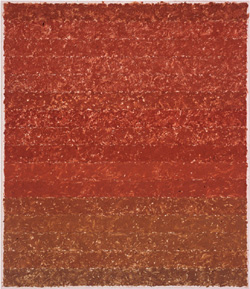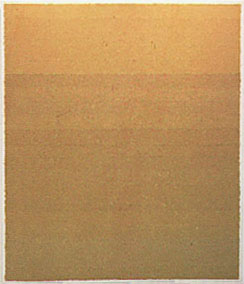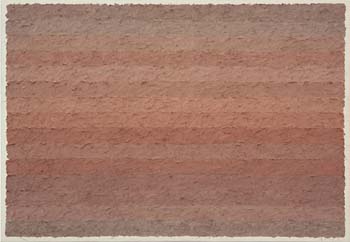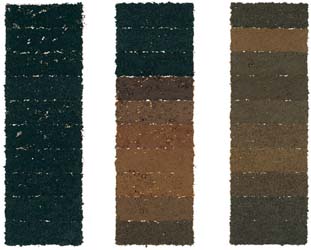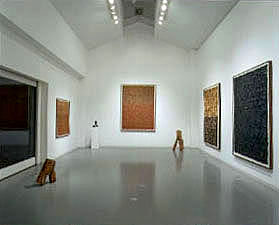Shintaro Ajioka's Ethics of Beauty
by Yoshikuni Iida
A strange feeling comes over me when I view Shintaro Ajioka's recent works. They are produced of various types of sand which have been excavated from different strata. The sand has been mixed with glue and then laid on canvasses.
How can I describe my impressions of these works? Is it similar to the pleasure of being embraced by something which is soft and vast? Or is it similar to being gently caressed by the primordial one?!
Each work consists solely of sand spread on the surface of a canvas. In none of these works is the artist's ego evident. Neither his will nor his emotions can be discerned. They remind one of the earthy walls of a Japanese house which have been stuccoed in a haphazard manner.
The viewer's eye is forcefully pulled over the grainy surfaces. Viewing them one imagines one is floating weightlessly in the infinite vastness of deep space. In this space an astronaut, paralytic with fright and ecstasy, might recognize the feeling engendered by viewing these works as the essence of vitality.
The experience could also be compared to encountering something eternally recurring in light traversing the darkeness of space.
It has been said that commencing with his "texture" series of the eighties Shintaro Ajioka has striven to unravel the secrets of the rules governing nature. I would agree.
In his works Ajioka has not attempted to "express" his inner self, but to discover "the laws of nature" and to arrange the elements of nature according to these laws. It is this lack of conscious self which makes his work so refreshing.
It can be argued that the arts in the 20th century have been employed by artists as a means for expressing their individuality. The reaction against much 20th century art is understanddable and was inevitable. And with Ajioka's work a means of negating or perhaps transcending the artist's conscious self has become apparent.
Shintaro Ajioka has made it a principle to proceed with a radical negation of his impulse to create.
The negation should, however, not be understood as his aim, but as a method to systematize nature. He embraces negation in order to discover the hidden laws of nature.
Every artist has an obligation to follow the laws of nature. But even for artists who fulfill their obligation there is no guarantee that their art will reveal the essece of nature. In order to perceive the essence of nature an artist must possess penetrating and logical sensitivity.
Shintaro Ajioka is one of few artists who possess the requisite sensitivity. The message his work conveys is firmly anchored to a wide ranging system. Hence his art has both depth and breadth.
What is his system like?
A number of pairs of adjectives come to mind: intensive and extensive, temporal and spatial, microcosmic and macrocosmic, naturalistic and speculative, phenomenal and essential, materially and humanistically oriented, spontaneous and constructive, etc.
Working through and with nature is necessary for Shintaro Ajioka. Consequently his work is an effective criticism of modernism. When viewing his most recent work, one confronts and grapples, as it were, with a severe and beautiful ethics. (2.3.1995)
